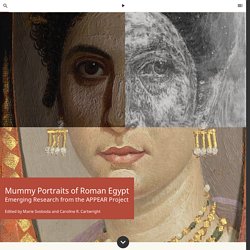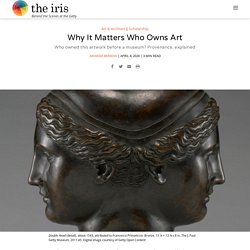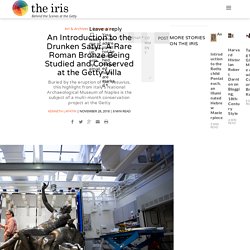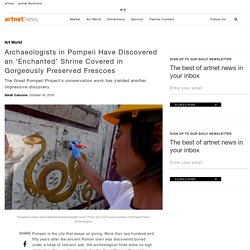

Mummy Portraits of Roman Egypt. Edited by Marie Svoboda and Caroline R.

Cartwright Once interred with mummified remains, nearly a thousand funerary portraits from Roman Egypt survive today in museums and galleries around the world, bringing viewers face-to-face with people who lived two thousand years ago. Until recently, few of these paintings had undergone in-depth study to determine how they were made. An international collaboration known as APPEAR (Ancient Panel Paintings: Examination, Analysis, and Research) was launched in 2013 to promote the study of these objects and to gather scientific and historical findings into a shared database. 132: Iconic Nefertiti – The History of Egypt Podcast. Bibliography Arnold, Dorothea.

‘Aspects of the Royal Female Image During the Amarna Period’. In The Royal Women of Amarna: Images of Beauty from Ancient Egypt, edited by Dorothea Arnold, 85–120. New York: Metropolitan Museum of Art, 1996. Bad Ancient - Fact-checking claims about the ancient world. Twitter. Let’s celebrate #museumweek #togetherMW with a walk INSIDE @villagiuliaRM with @museumweek @saverome. The Museum of the Imperial Fora. The city of Rome has some incredible collections from the sites of Rome (e.g., Capitoline Museums, National Museum of Rome), but no museum is more inherently archaeological than the city’s Museum of the Imperial Fora.

The entire museum is entirely housed in the Trajanic-era constructions (107-110 CE) known as Trajan’s Markets (a modern designation applied in the 1920s and 1930s excavation period), a complex of roads and buildings with shops over three distinct levels. No one knows what the Markets were used for. A shopping mall? An administrative center? Take a virtual tour inside a 5000 year old Egyptian tomb. The detail is amazing. India and the World. Why It Matters Who Owns Art. Double Head (detail), about 1543, attributed to Francesco Primaticcio.

Bronze, 15 ¼ × 13 ¾ x 8 in. This should be a required clip for every archaeology student, professor, and anyone else... Humor gets the point across like nothing else… A thread rating every amphora emoji □… Darius Arya sur Twitter : "Want to learn about Early Medieval Rome? Explore this little known museum text/ video- we introduce you to fabulous collections and art! Learn with @SaveRome and sign up for LIVE seminars at. Peeling Back the Messy and Myriad Layers of Tutankhamun’s Discovery. “Tut-mania” seems eternal.

Learn about Rome's People, Places & Monuments. Laocoön and His Sons. “Laocoön and His Sons” is one of the most famous ancient sculptures and a highlight of the Vatican Museums, ever since it was placed there on public display.

The statue depicts Laocoön, the priest of Apollo from the city of Troy, and his two sons. They are locked in the death coils of two serpents on the steps of an altar. Trojan War. Their Eyes Are Painted Soft: Discovering Hellenism in Egypt’s National Museum - The Pappas Post. Appear abstracts. The J. Paul Getty Museum. Participants.

Egyptian Mummy Portrait Mysteries Solved by New Getty Research Initiative. What’s more, the mummy paintings existed in scholarship limbo, falling somewhere between classifications of and Egyptian art.

They’d been made in a time of great cultural melding in Egypt, during the Roman occupation, and represent both Egyptian funerary traditions (mummification) and the Romans’ burgeoning experimentation with portraiture and painting techniques like —a painting method that entails melting beeswax and then adding colored pigments to it. “When they entered collections in the 19th century, mummy portraits were viewed more as curiosities because no one really knew what to make of them,” Svoboda told Artsy. “They weren’t completely Egyptian and they weren’t completely Classical—they were both.” An Introduction to the Drunken Satyr, A Rare Roman Bronze Being Studied and Conserved at the Getty Villa. Conservator William Shelley and preparator Rita Gomez of the Getty Museum oversee the sculpture’s safe arrival in the Getty Villa conservation studios.

Drunken Satyr, 1st century BC–1st century AD, Roman. Bronze, 137 cm high. Museo Archeologico Nazionale di Napoli, inv. 5628. Archaeologists in Pompeii Have Discovered an 'Enchanted' Shrine Covered in Gorgeously Preserved Frescoes. Pompeii is the city that keeps on giving.

Tut arrives in L.A., 1978 – LAPL Photo Friends. Portions of this essay were first published on the website HistoryLink.org. Jerry Anne DiVecchio, Food and Wine Editor for Sunset Magazine, admires the statuette of Selket. The sensuous goddess was one of the most popular artifacts in the collection, as testified to by sales of replicas. The photo is dated February 15, opening day, but was likely taken the day before at the press preview which was attended by some 600 reporters, editors, and photographers.
Why We Need to Start Seeing the Classical World in Color. Modern technology has revealed an irrefutable, if unpopular, truth: many of the statues, reliefs, and sarcophagi created in the ancient Western world were in fact painted. Marble was a precious material for Greco-Roman artisans, but it was considered a canvas, not the finished product for sculpture. It was carefully selected and then often painted in gold, red, green, black, white, and brown, among other colors. Women Rocked the Ancient World—But Ruling It Was Harder. ÉGYPTE - Jean-Claude Golvin. Rome: Capitoline Museums. Beyond the Nile: Egypt and the Classical World.
[Ancient Greek lyre, frame drum and finger cymbals play in the background] Female Narrator: Welcome to “Beyond the Nile: Egypt and the Classical World.” We often think of Ancient Egypt, Classical Greece and the Roman Empire as discrete and separate civilizations, but the ancient world was more fluid than we’ve been led to believe. This exhibition looks at the cultural and artistic connections between Greece, Rome and Egypt over a very long period of time – from the Bronze Age, just before 2000 BC, up until the Roman Empire. Here’s Jeffrey Spier. Jeffrey Spier: I’m Jeffrey Spier. Female Narrator: The exhibition is divided into four chronological periods. Whitewashing Ancient Statues: Whiteness, Racism And Color In The Ancient World. An Investigation of Black Figures in Classical Greek Art. Pitcher (Oinochoe) in the Form of the Head of an African, about 510 B.C., attributed to Class B bis: Class of Louvre H 62.
Terracotta, 8 7/16 in. high. The J. 10 Ways to Look at Ancient Greek Vases. Athenian Vases (Gallery 103) in the newly reinstalled Getty Villa One of the new spaces in the reinstalled Getty Villa is Gallery 103, a former coat-check area that has been converted into a room for the display of Athenian pottery. In devising the chronological and geographical layout for the Villa, we dedicated one gallery, 104, to Archaic and Classical Greece (800–323 B.C.), but didn’t want to overwhelm it with ancient pottery.
We also didn’t want to restrict one of the richest aspects of our collection to just two or three cases. The Royal Women of Amarna: Images of Beauty from Ancient Egypt. 7 Artists Reinventing the Ancient Art of Mosaics. López is known for her ambitious public art projects that have covered thousands of feet of her native Chile in mosaic tile. Making the Getty Villa’s New Audio Guide. How do you make the old feel new? This was the initial question I asked myself when producer Tim Halbur and I were tasked with developing the Getty Villa’s new interpretive audio guide.
The next two questions I asked were: How can we inspire a vital connection to objects that are more than 2,000 years old? The Adventures of the Parthenon... - Greece High Definition. The Virtual Museum of Iraq.
Prehistoric Aurochs Image Opens Up A New View Of Human Evolution : 13.7: Cosmos And Culture. A limestone slab engraved with an image of an aurochs, or extinct wild cow, discovered at Abri Blanchard in 2012. Ph. Jugie/Musée National de Préhistoire hide caption toggle caption Ph. Jugie/Musée National de Préhistoire A limestone slab engraved with an image of an aurochs, or extinct wild cow, discovered at Abri Blanchard in 2012. We Homo sapiens have been artists throughout much of our prehistory, creating paintings, engravings and statues, often representing animals. Laughing at the Jokes on Ancient Greek Vases. PRINCETON, NJ — Too many Greek vase jokes are lost in translation. For example, this duel between Achilles and Hector looks serious. Why Male Nudes In Ancient Greek Art Are Meagerly Endowed – ArtsJournal. True Colors. To find out what the Greek gods looked like, it would seem reasonable to start in Room 18 of the British Museum. Greece High Definition - Vidéos.
Stroll in Emperor Nero's garden with Rome virtual tour. ROME(AFP).- It's a breathtaking view and you can almost smell the lavender: visitors to Rome can now stroll through Emperor Nero's Golden House and sumptuous gardens thanks to a new virtual tour. [Exclusive] Interview with Dr. Markus Hilgert, Director of Vorderasiatisches Museum im Pergamonmuseum. A History of the World - Object : Statue of Ramesses II. Connections. Robin Schwalb1280853 Chinese Characters | 2006 | Robin Schwalb | Quilt | Collection of John M. Walsh III1280952 "Mondrian" day dress | autumn 1965 | Yves Saint Laurent (French, born Algeria) | Wool jersey in color blocks of white, red, blue, black, and yellow | Gift of Mrs. William Rand, 1969 (C.I.69.23)6521024 Watertowers | 1967–80; printed 1980 | Hilla Becher (German) and Bernd Becher (German) | Gelatin silver prints | Warner Communications Inc.
Connections. Nancy Wu1280852 Reims Cathedral, West Façade | © Nancy Wu6851024 Reims Cathedral, view of nave toward east | © Nancy Wu1280857 Prayer in the Mosque | 1871 | Jean-Léon Gérôme (French) | Oil on canvas | Signed (upper right, on beam): J.L.